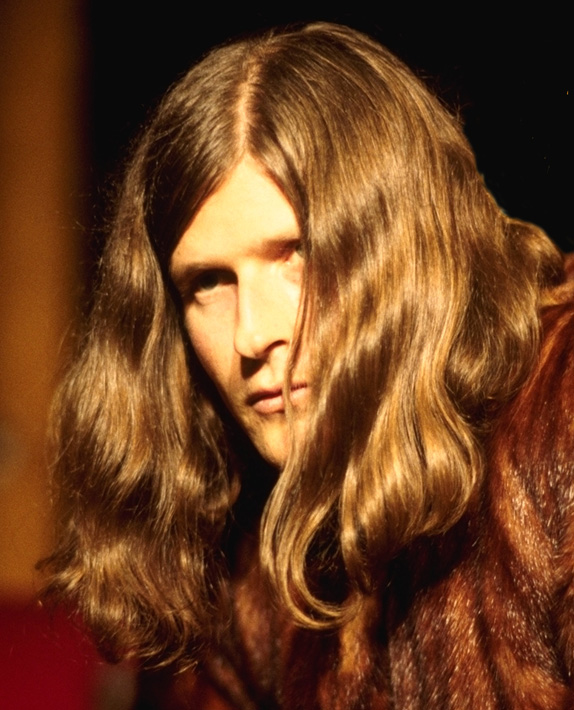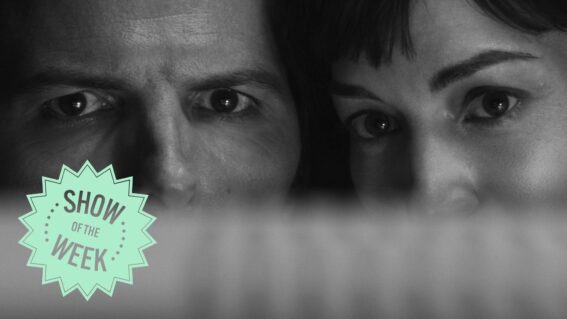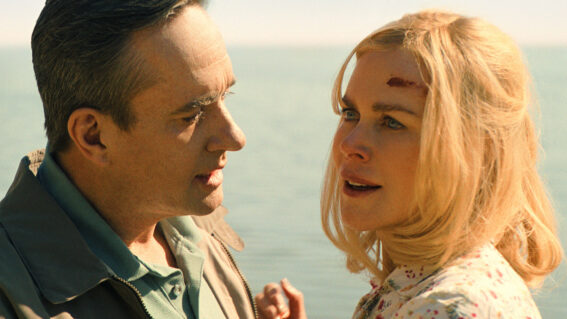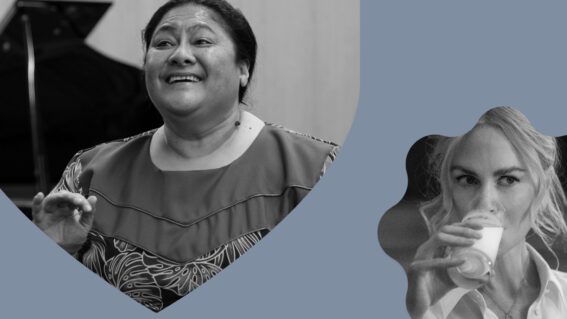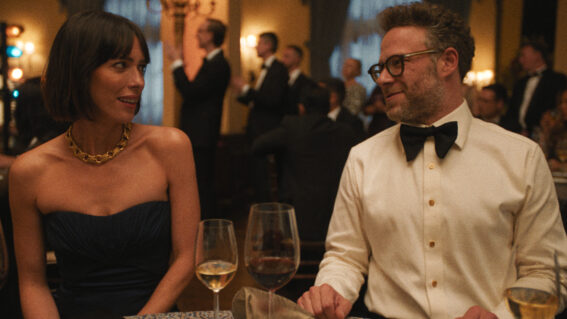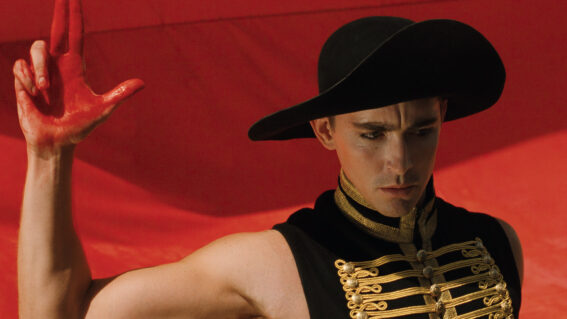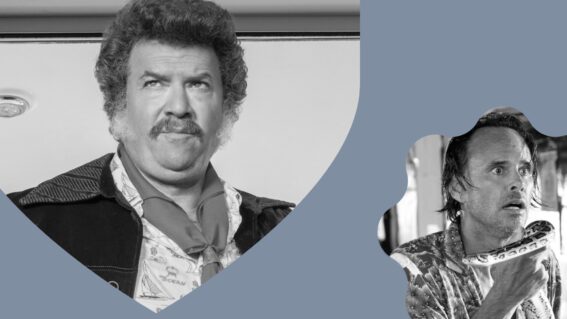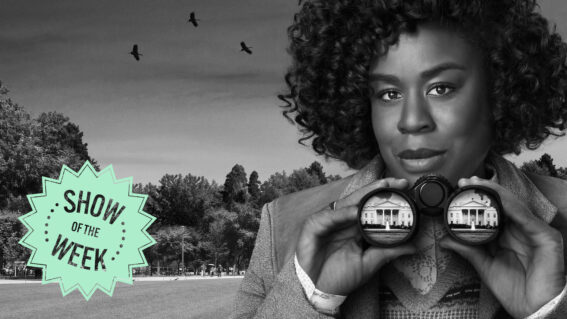Interview: Crispin Glover
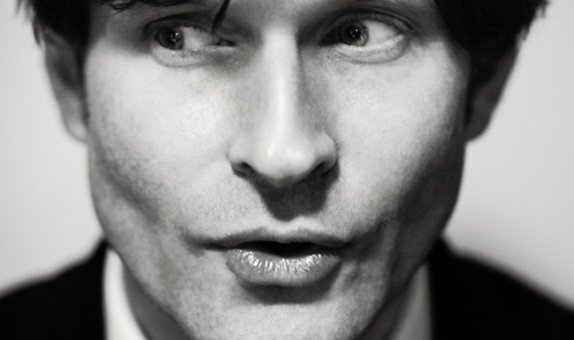
We’re very excited about the impending arrival of Crispin Glover to New Zealand. Visiting these shores for the first time, the actor/director/screenwriter/artist/performer can be seen on March 16th and March 17th at the Dunedin Fringe and at Auckland’s Skycity Theatre on March 19th. Glover brings with him a reputation as an unconventional actor earned through his roles in films such as Back to the Future, River’s Edge and Charlie’s Angels. His shows here offer more insight into his own creativity as Glover, on alternating nights, presents Crispin Hellion Glover’s Big Slide Show Part 1 and Part 2, screens his films What is it? and It is fine! EVERYTHING IS FINE! and engages audiences in a Q&A. We were delighted to talk to Glover in the following conversation, augmented with email correspondence, that sheds light on what you can expect from the shows and how he has gone about putting them together.
FLICKS: One of the things that’s going to bring a lot of people to the show, people that have curiosity in your own films, is what you’ve done elsewhere. Is there a connection that you can see between the performances that we’re familiar with, with your work for other directors, and your work as a director and writer yourself?
CRISPIN GLOVER: I think people will find it different. The first film I wrote [What Is It?], and the second film [It is Fine! EVERYTHING IS FINE!] is written by a man named Steven C. Stewart, who’d been born with a severe case of cerebral palsy and had been locked into a nursing home when he was in his early twenties, when his mother died. The people that were taking care of him, would call him an MR, a mental retard. Which is not a nice thing to say to anybody, but Steve was of normal intelligence and the emotional turmoil he must have gone through for the decade he was in a nursing home, I can’t even begin to imagine. When he got out, he wrote the screenplay, and there’s something quite unique about this film. When the whole trilogy is done, this film will be the best film of the trilogy, but not only that, I feel like it will be the best film I’ll have anything to do with in my whole career. The first film, I don’t mean to dismiss that, because I’m also extremely proud of it.

Now of course when you’re asking if these films have to do with my own career, I didn’t write the second film, so it’s very different. Even from my first film, What Is It?, they’re very different kinds of movies, and What Is It? also does not feel like a movie that people are used to seeing me in that I’ve acted in. And also my performance, in that film, feels different than performances that people will see me in… usually. It’s a little bit hard to describe as to why, but the films feel different from what you’ll standardly see, in a corporately funded and distributed film.
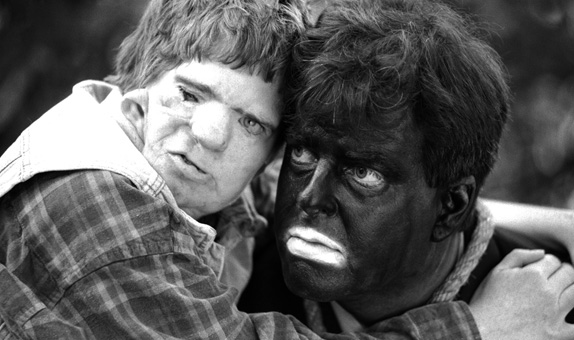
The first film, What Is It? really is my psychological reaction to the corporate constraints that have happened in the last thirty years of filmmaking, where anything that can possibly make an audience member uncomfortable is necessarily excised or that film will not be corporately funded or distributed. I think that’s a very damaging thing, because it’s that moment, when an audience member sits back on their chair, looks up at the screen and thinks to themselves, “Is this right, what I’m watching? Is this wrong, what I’m watching? Should the film maker have done this, what is it?” And that’s the title of the first film.
“What does it mean when the taboo has been ubiquitously excised?”
What is it that’s taboo in the culture? What does it mean when the taboo has been ubiquitously excised? Again, I think this is a very damaging thing because when people are asking a question, that’s when there is a genuine education, when people are thinking and questioning things. When there’s no genuine questioning, what can happen, and I think what is happening is, the opposite of true education. Unfortunately, what is happening is propaganda, and that’s not a good thing. So the first film, What Is It?, is reacting to that.
Does the Q and A function as a balance to the film then? Where the film raises a lot of questions, and then you’re in person there, to address the audience?
Yes. What I’m trying to do is not so much about specifics, of the content of the film or films, as much as it is about the context within which the films have been made, and what the reaction is. Because there is not a lot of filmmaking that is specifically reactionary, to those kinds of confinements, I think people sometimes can get confused as to what it actually is that’s being reacted to. And that’s what I’m trying to put in at the question-and-answer periods.
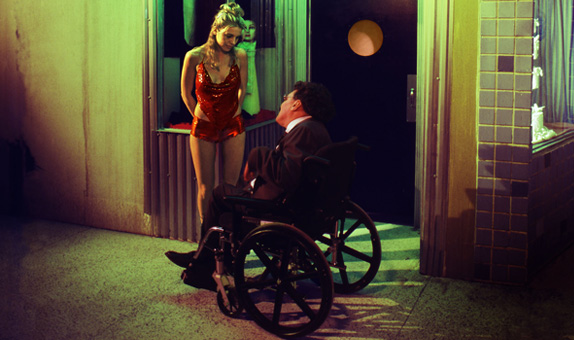
Sometimes people are very aware of what I’m talking about already. But often people aren’t thinking about that because the media is relatively ubiquitous, in terms of what is being put forth from corporate interests. And that influences the culture a lot, more than one may really even begin to think of, at first.
Do you encounter some very familiar preconceptions in that forum as the show travels around?
Well, most of the time, most of the audience members that are coming to see the show, they’ve seen me in some films, and they’ve seen that there is something unusual, already. So on some level, many of the audience members are looking for something more unusual, right from the outset, but some people are not necessarily knowing quite what that might be and sometimes there’s very active… discussion in the Q & A’s, which I welcome. It’s definitely a part of what the purpose of the filmmaking has been, so I’m always glad when I feel like there’s some kind of passionate questioning that’s happening.
Thinking specifically about New Zealand audiences, it’s quite unusual for us to interact with an artist from the northern hemisphere. What’s it like for you, interacting with your audiences as you travel around the world with your show?
Well, sometimes I notice slight differentiation in reactions. But for the most part I really experience a very positive interaction. It’s something which is quite useful, or quite wanted and has been phased out. There were films originally that had an interlocutor or a narrator when they were silent, or before that, there was something called magic lanterns. And there would be a narrator, and there was live performance that had interactivity and then films branched off and really stopped having an interactive element, after Vaudeville, really, stopped by the 1950’s, or, 60’s, particularly. These elements of human interaction ceased to be as strong, and I just can tell that people really get a lot out of it.
It really has less to do with Northern and Southern hemisphere, and more just to do with people enjoying the aspect of human interaction, particularly with film, which has stopped having that human interaction, in a certain way. And it’s made it so that it’s harder to get people into a theatre for cinema, for example, than it is maybe to get people in to see a music performance. I think because people, when they think about a music performance, we maybe think there will be liquor and there will be somebody – a guy or girl, if they want to meet, and there will be a social element with it. But with film, you kind of think about going to the cinema maybe alone, lights come down, you watch the film alone, and then you go home, alone. And that’s not necessarily as attractive as some kind of social event for you.
“people often, when they come to see the shows, know or believe they’re going to get something that’s a bit different. which is true”
I have a question-and-answer after the film. First of all, I have the one hour live performance. Then there’s the film. Then I have a Q&A session, which usually goes about an hour and a half, and then there’s a book signing where I talk to the people and sign the books until everybody that’s been in line has been met. And I found that those last portions of the show, are equally – maybe even more – important, than the film and the performance itself. Of course, the film and performance are important, because it gives a view point of thought process that’s put forth, which helps to frame maybe something that’s a bit different than what people are necessarily expecting to see. And I know people often, when they come to see the shows, know or believe they’re going to get something that’s a bit different, which is true. But even still, how can one know what it’s going to be until they’ve seen it, particularly with the film.
As you operate in two very different film worlds at the same time, is it interesting to you to have strong opinions about corporate films? To work on your shows, and then a few days later be going on set for a big production?
Well, if anything has happened is, it’s made me more grateful to be working in the corporate situation, than ever. Which sounds a bit strange, but it’s true. I’ve been able to fund my films and take the time for touring with my films because I’ve work in the corporate situation. And I’m not really critical of the people in the corporate situation, I’m more critical of the systematization that corporate filmmaking makes people fit into. And I can tell that there are all kinds of great people, I know there are all kinds of great people, in the film community that want to be asking questions and making thoughtful films. And I can see them, there’s this systematization, that people end up having to fit into, which can deaden some of that.
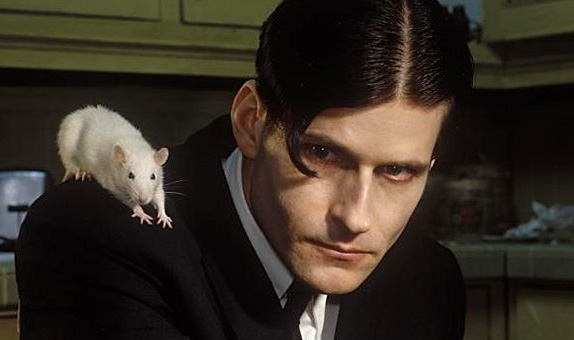
But, when I’m acting in other people’s films, people often are looking for me to be playing a more unusual or kind of thoughtful, questioning element, or that the film has that in the first place. So, I always have a very good attitude, I’m always very happy to be working and being a part of something that I had studied… utilizing a craft I had studied, starting at age 15 till 20. And my father’s an actor, and he taught – still, he teaches acting. I’ve been around that for a very long time, so it’s good to be able to practice a craft that I had learned, at a young age. Even if I have questions and certain critical thought processes about the, like I say, systematization that I feel has continually encroached upon the corporate situation.
To still be in any line of work that has been with you since the age of 15, that’s a real accomplishment in itself.
Yes, I’m glad to. Actually, I started studying when I was 15, but I started professionally when I was 13, so, it’s even longer than that. I’ve been in the business for a long time. It’s something that I’ve always done, and from before I was an adult, so I prefer to continue, as opposed to not continue.
The sort of training that I had or acting focused on bringing portions of your own psychology to make those characters have an organic quality. Something that is important to understand is that those who appear in corporately funded and distributed films and more importantly the content of are corporately funded and distributed films is not determined by the populace of the culture, but by the corporate interests that are funding and distributing the films. If an actor willingly cheerleads the corporate interests that actor will be rewarded with money, media backup/publicity and consequently more work that sustains the corporate interests.
Around the time I started acting in films in 1982 there was a shift in the kinds of films that were being corporately funded and distributed.
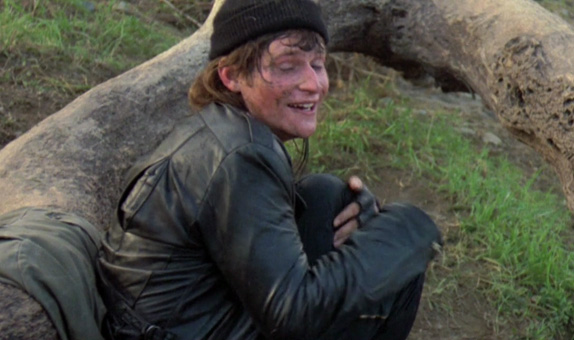
The film industry I had thought I had stepped in to was the spirit of when I was a teenager attending the various revival theatres that were so popular in Los Angeles in the 1980s before home theatre business competition forced most 35 mm venues to close. I did not realize at the time that I stepped in to working as an actor that the kinds of films that were being funded and distributed had changed. As soon as I got my driver’s license when I was 16 in 1980, I attended screenings at revival theatres that were quite popular in LA before VHS competition cleared many of them away. Many of these revival theatres no longer exist such as, one of my favourites, the beautiful Fox Venice with a wide cinemascope screen on Lincoln Blvd.
The films I saw that played in these venues tended to question culturally accepted truths with performances that underscored these concepts.
Films played such as: Ken Russell’s The Devils, Roman Polanski’s Repulsion and Chinatown, Frederico Fellini’s 8 1/2 and Casanova, John Cassavetes’ A Woman Under the Influence, Orson Welles’ F for Fake and Citizen Kane, Billy Wilder’s The Apartment and Sunset Boulevard, John Waters’ Pink Flamingos and Desperate Living, Todd Browning’s Freaks, Stanley Kubrick’s 2001, A Clockwork Orange and Dr. Strangelove, Werner Herzog’s Aguirre Wrath of God, Even Dwarfs Started Small and Fata Morgana. I was a regular attendee of David Lynch’s Eraserhead at midnight on Fridays at the Nuart.
I studied actors giving performances like: Jack Nicholson in Five Easy Pieces and Easy Rider, Timothy Carey in Marlon Brando’s One Eyed Jacks and Elia Kazan’s East of Eden, Charles Laughton in The Hunchback of Notre Dame, Brad Dourif in One Flew Over the Cuckoos Nest and Wise Blood, Peter Lorre in M, Emil Jannings in The Last Laugh and Klaus Kinski in Aguirre Wrath of God.
These films and performances characterized the atmosphere of cinema and acting I believed I was stepping into as a young actor. By 1982, at age 18, I began to act in feature films. At this time I believed contemporary culture’s films’ main purpose was to question suspect things in our culture. I enthusiastically supported the idea of questioning our culture. To help support the idea, I also questioned the film industry’s and media’s messages. Sometimes I felt scorned and isolated; other times I felt accepted and admired. Then, at one point, in the midst of my career, I realised that the types of films the industry was financing and distributing had changed almost diametrically from the types of films I had watched when I was 18.
These different creative strands that you have to your work now, were those things that, at a young age, you saw yourself doing? Being a director, being a writer, being a performer, or have they’ve just been things that presented themselves along the way?
I’d always written and drawn, since a very young age. And the books I started making when I was 18, it’s funny how it ended up correlating into, a really very important aspect of my life, that I had never expected, would anywhere be as important as it currently is, which I’m glad about.
I started making my books in 1983 for my own enjoyment without the concept of publishing them. I had always written and drawn and the books came as an accidental outgrowth of that. I was in an acting class in 1982 and down the block was an art gallery that had a book store upstairs. In the book store there was a book for sale that was an old binding taken from the 1800’s and someone had put their art work inside the binding. I thought this was a good idea and set out to do the same thing. I worked a lot with India ink at the time and was using the India ink on the original pages to make various art. I had always liked words in art and left some of the words on one of the pages. I did this again a few pages later and then when I turned the pages I noticed that a story started to naturally form and so I continued with this.
When I was finished with the book I was pleased with the results and kept making more of them. I made most of the books in the ’80s and very early ’90s. Some of the books utilize text from the binding it was taken from and some of them are basically completely original text. Sometimes I would find images that I was inspired to create stories for or sometimes it was the binding or sometimes it was portions of the texts that were interesting. Altogether, I made about 20 of them. When I was editing my first feature film What is it?, there was a reminiscent quality to the way I worked with the books because as I was expanding the film into a feature from what was originally going to be a short, I was taking film material that I had shot for a different purpose originally and re-purposed it for a different idea and I was writing and shooting and ultimately editing at the same time. Somehow I was comfortable with this because of similar experiences with making my books.
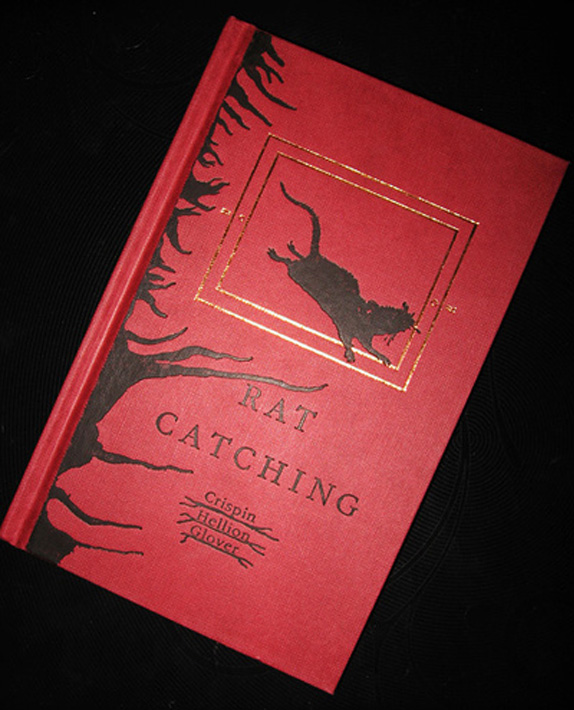
When I first started publishing the books in 1988 people said I should have book readings. But the book are so heavily illustrated and the way the illustrations are used within the books they help to tell the story so the only way for the books to make sense was to have visually representations of the images. This is why I knew a slide show was necessary. It took a while but in 1992 I started performing what I now call Crispin Hellion Glover’s Big Side Show Part 1. The content of that show has not changed since I first started performing it. But the performance of the show has become more dramatic as opposed to more of a reading. The books do not change but the performance of the show of course varies slightly from show to show based the audience’s energy and my energy.
People sometimes get confused as to what Crispin Hellion Glover’s Big Slide Show (Parts 1&2) is so now I always let it be known that it is a one hour dramatic narration of eight different profusely illustrated books that I have made over the years. The illustrations from the books are projected behind me as I perform the show. There is a second slide show now that also has eight books. Part 2 is performed if I have a show with Part 1 of the “IT” trilogy and then on the subsequent night I will perform the second slide show and Part 2 of the “IT” trilogy. The second slide show has been developed over the last several years and the content has changed as it has been developed, but I am very happy with the content of the second slide show now.
Are there any things specifically about your trip to New Zealand that you’re looking forward to?
Yes, I’ve never been to New Zealand. The closest I’ve been is to Australia, a whole different place. So I’m looking forward to seeing the land and landscape and, of course, the people. That’s certainly a part of what I’ve enjoyed, about touring is. I’ve gone to a lot of places that I would have not necessarily gone to. And, New Zealand, I think, is probably about as far away as I’ve been. I am speaking to you from the Czech Republic right now but I live in Los Angeles. I think it’s even further away from the Czech Republic. I’ll have another show, on the East Coast of the United States, then I fly to Los Angeles. I’m just there for a day, and then I fly out to New Zealand for the shows. So, I think I’m halfway around the world right now.
You’re currently chatting to me from the Czech Republic. Has work taken you there?
I own property here, where I’ve been building sets for my next productions. At the same time the sets are being built I am in the process of continuing to develop the screenplay for myself and my father to act in together on these very sets. He is also an actor and that is the next film I am planning to make as a director/producer. This will be the first role I write for myself to act in that will be written as an acting role as opposed to a role that was written for the character I play to merely serve the structure. But even still on some level I am writing the screenplay to be something that I can afford to make. There are two other projects I am currently developing to shoot on sets at my property in the Czech Republic. The cost of the set building will determine which one I actually shoot next. They are will all be relatively affordable yet still cinematically pleasing.
Crispin Glover’s New Zealand performances:
Saturday March 16th, Dunedin Fringe – Crispin Hellion Glover’s Big Slide Show Part 2, It is Fine! EVERYTHING IS FINE!, Q&A and book signing.
Sunday March 17th, Dunedin Fringe – Crispin Hellion Glover’s Big Slide Show Part 1, What is It?, Q&A and book signing.
Tuesday March 19th, Skycity Theatre Auckland – Crispin Hellion Glover’s Big Slide Show Part 2, It is Fine! EVERYTHING IS FINE!, Q&A and book signing.
For more information about Crispin Glover’s shows and films visit www.crispinglover.com

